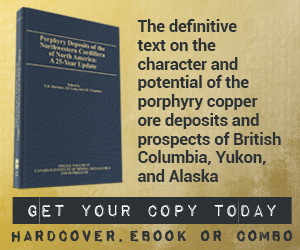Library Magazine Articles CRIRSCO and international reporting standards
CRIRSCO and international reporting standards
Deborah McCombe - May 2011
Prior to the Committee for Mineral Reserve International Reporting Standards’ (CRIRSCO) annual meeting held on September 27, 2010, in Moscow, CRIRSCO and the Russian State Commission on Mineral Reserves (GKZ) held a seminar on Russian and International Mineral Reserves/Resources Standards. Each of the CRIRSCO representatives reported on the status of their country’s codes/rules for reporting Mineral Resources and Mineral Reserves (Paul Bankes and I represented CIM):
- Australia – Preparations are underway for a revision to the JORC Code with an objective of finalizing it by the end of 2011.
- Canada – The Canadian Securities Administrators (CSA) are reviewing NI 43-101 with July 2011 as the target date for completion of the revision.
- Chile – The number of Qualified Competent Persons who are registered is increasing, and training is continuing on the use of the new Chilean Code.
- Europe – The Pan European Reserves and Resources Reporting Committee (PERC) continues to lobby to have the PERC Code accepted by the various European stock exchanges and regulators.
- South Africa – The South African Codes are being reviewed, but there is no timetable at this time for revision of the 2007 Code.
- United States – The number of SME Registered Members has increased and this is expected to continue to grow if the application to be registered as a Foreign Association under NI 43-101 is successful. SME is still actively trying to convince the SEC to align with the CRIRSCO Template and adopt the SME 2007 guide for mineral reserve and resource definitions disclosure.
United Nations Framework Classification
CRIRSCO representatives continue to participate in the deliberations of the United Nations Framework Classification (UNFC) Revision Taskforce. At the October 2009 meeting, a revised UNFC was adopted (UNFC 2009) and in April 2010, a UN Specifications Task Force met and identified specifications and guideline issues to consider.
International Accounting Standards Board
The International Accounting Standards Board’s (IASB) extractive industries project team issued a working draft on the valuation of Mineral Reserves for comment. CRIRSCO representatives have been working closely with the project team and the IASB Minerals Industry Working Group.
Alignment of Russian reporting standards and CRIRSCO template
The Guidelines on Alignment of Russian reporting mineral reporting standards and the CRIRSCO Template was developed throughout the year. It was signed by representatives of CRIRSCO and GKZ (the Russian State Commission on Mineral Reserves) during the Moscow meeting and is available on the CRIRSCO website. PERC was active in developing this guideline, aligning Russian reporting standards with the CRIRSCO Template (a generalized reporting code developed by CRIRSCO).
A collaboration agreement has been prepared linking CRIRSCO, GKZ and the Russian Society of Subsoil Use Experts (OERN). Its main objective is to develop a public reporting code in Russia by the end of 2012 that will be compliant with the CRIRSCO Template. It will not replace the internal reporting standards for government purposes.
Core definitions in the CRIRSCO Template
Over time, the major definitions contained in the CRIRSCO family of codes have drifted from the commonality achieved in the Denver Accord of 1997. With more international exposure of the CRIRSCO Template, it was agreed that it would be preferable if 13 core definitions could be standardized for the CRIRSCO Template and then these definitions be adopted into each country’s codes/rules and standards. It was recognized that even though the basic definitions could be the same, there was a need to have accompanying guidance to reflect the situation pertaining to each jurisdiction.
CRIRSCO members agreed in principle on the core definitions for Public Reports, Competent/Qualified Persons, Modifying Factors, Exploration Results, Mineral Resource, Inferred Resource, Indicated Resource, Measured Resource, Mineral Reserve, Probable Reserve, Proved Reserve, Pre-feasibility Study and Feasibility Study. These definitions will be referred to each national reporting organization (such as CIM in Canada) for their consideration. See the CRIRSCO website for more information.
Material beyond Inferred Resources
A paper prepared by Niall Weatherstone on “Material beyond Inferred” generated considerable discussion. The CRIRSCO Template does not provide for material that does not qualify for classification as a resource. Other classification systems, such as UNFC and Petroleum Resources Management System (PRMS), find a place for each and every category of mineralization. Some CRIRSCO family codes have provisions for discussing material that has the potential to be, but is not currently, a resource. The document was presented as a discussion draft and is on the CRIRSCO website. There is no intention to modify the CRIRSCO Template or the basic diagram showing the relationship of the CRIRSCO categories. Rather, the aim is to show the CRIRSCO position regarding other categories.
Other business
CRIRSCO’s strategic relationship with ICMM has been formalized for three years. Regular communications take place between the parties and the objective is to provide mutual support for each group’s activities. ICMM is a major contributor to the costs of running CRIRSCO. The support of ICMM, national reporting organizations and employers through funding and provision of time was gratefully acknowledged.
On July 1, 2011, I will take on the position of Chair and Edmundo Tulcanaza (Comision Minera) will become the First Deputy Chair. Ian Goddard (JORC) will continue as Second Deputy Chair.
Author
Deborah McCombe, executive vice-president of Scott Wilson Roscoe Postle Associates, is a consulting geologist strongly involved in Canadian disclosure standards for the mining industry.

.png)
